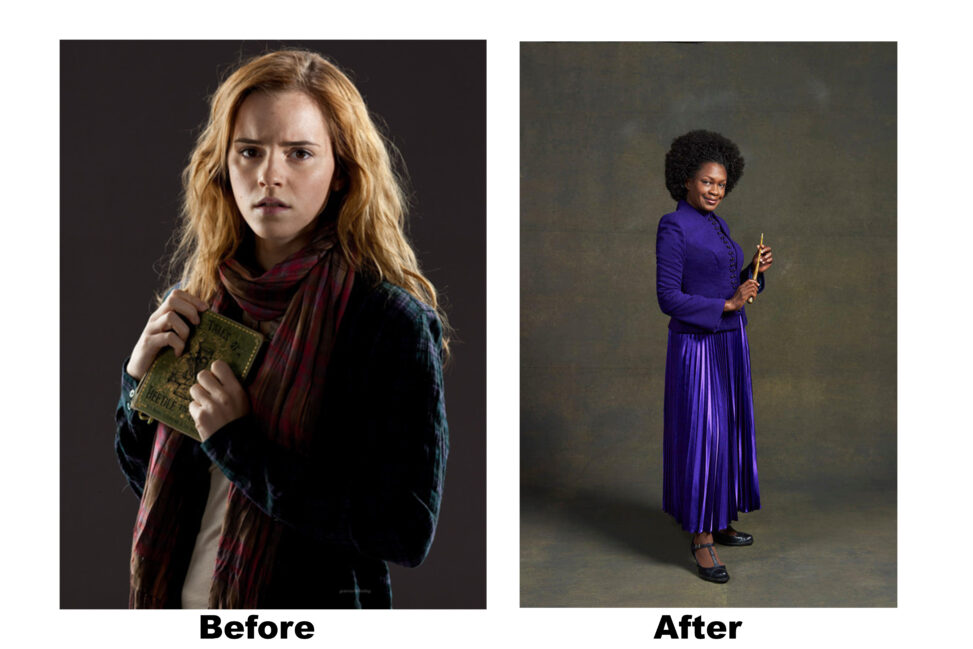Hermione Granger was first brought to life in the cinematic world in 2001 with the release of Harry Potter and the Sorcerer’s Stone. She was portrayed by Emma Watson for 10 years until the series came to its end in 2011. Hermione faced criticism as a character throughout the history of the franchise – a young girl who was independent, clever, and intellectually-inclined was instead seen as “pretentious, snotty, and bossy”. However, Hermione was the representation that a lot of young girls needed in order to realise that being smart and ambitious is a force, and not something to quiet down or be ashamed of. It wasn’t until 2016 that Hermione Granger came to life again with the original West End production of JK Rowling’s “The Cursed Child” – a story that follows the three main protagonists of the original series and their children, 19 years after the ending of the original series.
The script was released before the production took stage, and was received with mixed reviews from critics and fans of the franchise alike for the confusing plot, and the underdeveloped characters. The biggest shock and controversy came when the play premiered in 2016, shortly after the script was released. Hermione Granger and her daughter, Rose, were being portrayed on stage by two black women. Because of Hermione’s previous depiction as a white woman, there was widespread outrage that changing a character’s race is unacceptable, especially when so many people grew up with it and have developed para-social ties to it.
However, between the 7 books and 8 movies that Hermione Granger was a part of, her race was never a plot point or a point of interest for her character. In fact, it was never explicitly stated that she was white at all. This is because the film series was not about Hermione Granger’s experience as a white woman in Britain, and furthermore, the Cursed Child continuation of the series is not a commentary on a black woman’s experience. They are Hermione Granger’s experience as a witch in a fantasy world of wizards and warlocks, and magic and monsters, with their own belief systems, prejudices, and hierarchies that have nothing to do with race.
The issue of black women being misrepresented in film and television has existed since the early days of how people of colour are portrayed in the media. Hermione is intelligent, ambitious, and level-headed. She is never referred to as “cool,” though. For a long time, Black people in the media have needed to be exotic or edgy in order for their personalities to have inherent worth or a justification for inclusion. This is how stereotypes of side-kick black characters, like the Angry Black woman, and The Thug are born.1 Kandice Rose says it best: “A black Hermione indicates that we no longer have to remain as the “cool” thing, though hip hop is trendier than ever, and that now we can be the “everyday thing””2
The way that black women’s romantic relationships are portrayed in the media is another example of how they are stereotyped and misrepresented. According to a study done in 2021 by The Geena Davis Institute on Gender in Media, “Black women are less likely than white women and other women of color to be shown in a romantic relationship, but more likely to be shown as having at least one sexual partner”3. Hermione being depicted as both a black woman and a woman in a committed, happy relationship changes the narrative that has been pushed in the media for so long that black women are not capable, or deserving of, romantic, committed, long-term relationships. The social and cultural elements that shape our thoughts, emotions, and actions toward ourselves and others are known as socio-cultural ideals.4 The internalisation of these ideals is when we accept what is being said about us to be true.5 In this instance, the media’s portrayal of black women as unworthy or incapable of being in committed, long-term, romantic relationships might affect how these women feel about themselves. “Individuals consistently exposed to media content over a prolonged period tend to interpret social realities based on how they are portrayed.”6
This kind of representation is important because pop culture and media effects alter how we think about ourselves. It wasn’t until I saw Sue Storm, ie, Superwoman, sporting glasses while simultaneously being brave and strong that I thought it was cool and powerful to wear my own. Mass media is meant to be consumed, and anything that is consumed is intended to affect us. Positive representation in media matters because black people matter, women matter, and the individual experience matters. Jenny Jules who portrayed Hermione Granger in The Cursed Child, puts it best; “I just know that young women of color are coming into the theater, seeing me as Hermione … and are seeing me with my afro hairstyle, and it takes their breath away,” Jules added. “And they’re just going, ‘There I am, I’m represented in this story.‘ How amazing is that?” 7
Bibliography / Endnotes
1. Nittle, Nadra Kareem. “Common Black Stereotypes in TV and Film.” ThoughtCo.Com, (July 31, 2024). https://www.thoughtco.com/common-black-stereotypes-in-tv-film-2834653.
2. Rose, Kandice, “Black girl magic: the (re)imagining of Hermione Granger: an analysis and autoethnography” (2021). College of Liberal Arts & Social Sciences Theses and Dissertations. 306. https://via.library.depaul.edu/etd/306
3. Representations of Black Women in Hollywood, 2021, Geena Davis Institute on Gender in Media, https://geenadavisinstitute.org/research/representations-of-black-women-in-hollywood/
4. Russello, Salenna, “The Impact of Media Exposure on Self-Esteem and Body Satisfaction in Men and Women,” Journal of Interdisciplinary Undergraduate Research: Vol. 1 , Article 4. (2009)
5. Cherry, Kendra. “Sociocultural Theory: Examples and Applications.” Verywell Mind, (July 12, 2024.) https://www.verywellmind.com/what-is-sociocultural-theory-2795088.
6. Chi-Horng Liao, “Exploring the Influence of Public Perception of Mass Media Usage and Attitudes towards Mass Media News on Altruistic Behavior,” Behavioral Sciences 13, no. 8 (July 26, 2023): 621, https://doi.org/10.3390/bs13080621.
7. Erika Milvy, “Nine Black Hermiones, and ‘Harry Potter and the Cursed Child’ Still Won’t Talk Race,” LaTimes.Com, (December 1, 2019), https://www.latimes.com/entertainment-arts/story/2019-12-01/black-hermione-harry-potter-cursed-child.
photos – https://www.harrypotterfanzone.com/san-francisco-cursed-child-cast-portraits/
https://phoenixweasley.wordpress.com/category/hermione-granger/page/9/


Isabella Tiani
Good afternoon Sara! I believe that your analysis of the two images was very successful. You described what people know as Hermione very well as many people grew up with the movies and are used to seeing the Harry Potter Franchise everywhere. I personally did not know that there was another rendition of Hermione Granger. I believe that you outlined the differences in great detail, which made your analysis and comparison stronger. I believe your main points that you hit is what people are used to Hermione Granger as, and how the change caused major uproar within audiences. The change caused uproar due to racism within our society and people not being able to accept the changing of characters that they are used to. Your scholarly sources tied into your analysis well and they made your argument much better. The two images atop your analysis illustrated the discussion you depicted as two different Hermiones and how people could not grasp the difference amongst the change and how some people could and how it can further diversity and change within our society.
Isabella Tiani
Sorry for the technical difficulties, I accidentally submitted my first comment without adding a few other notes, I meant to add. Your use of scholarly sources was bountiful, which allowed for multiple avenues of discussion to open up. By using multiple authors and different streams of media, the discussion is allowed to be furthered in a way that is not just an analysis but a experiment in which society accepts certain depictions of characters but not others.